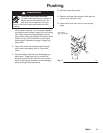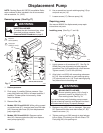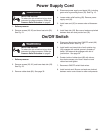
20 308801
Motor Test
WARNING
INJECTION HAZARD
To reduce the risk of serious injury, when
instructed to relieve pressure, follow the
Pressure Relief Procedure on page 8.
For checking armature, motor winding and brush
electrical continuity.
Setup
1. Unplug sprayer.
2. Remove drive housing. See page 26. This is to
ensure that any resistance you notice in armature
test is due to motor and not to worn gears in drive
housing.
3. Remove motor brush inspection covers (A). See
Fig. 12.
4. Remove screws (25, 26). Lower control board
(22a). Disconnect two leads (C) from motor to
board. See Fig.13.
A
B
Fig. 12
02991
Armature Short Circuit Test
1. Remove fan cover (B). See Fig.12.
2. Spin motor fan by hand. If there are no shorts, the
motor will coast two or three revolutions before
coming to a complete stop. If the motor does not
spin freely, the armature is shorted and the motor
must be replaced. See page 23.
Armature, Brushes, and Motor Wiring
Open Circuit Test (Continuity)
1. Connect red and black motor leads (C) together
with a test lead. Turn motor fan by hand at about
two revolutions per second. See Fig. 13.
7869B
Fig. 13
77
67
30
80
78
C
22a
96
D
E
black
green
white
black red
yellow
107
108
2. When turning the fan on a DC motor, normally you
sense an even, pulsing resistance. If there is
irregular turning resistance, or no turning resis-
tance, check and repair the following as needed:
broken brush springs, brush leads, motor leads;
loose brush terminal screws or motor lead termi-
nals; worn brushes. See page 21.
3. If there is still uneven or no turning resistance,
replace motor. See page 23.


















